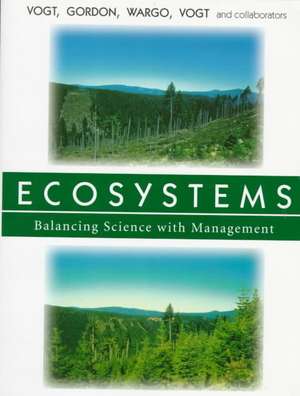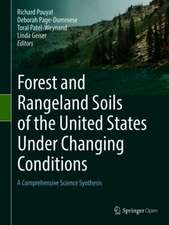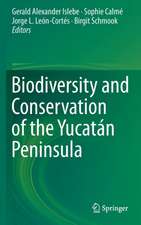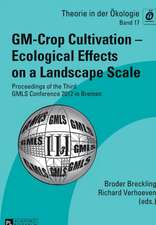Ecosystems: Balancing Science with Management
Contribuţii de B. Larson Autor Kristiina Vogt, John Gordon Contribuţii de D. Tortoriello Autor John Wargo Contribuţii de J. Perez Autor Daniel Vogt Contribuţii de A. Marsh Autor Heidi Asbjornsen Contribuţii de M: Corbett Autor Peter A. Palmiotto Contribuţii de K. Kaneda Autor Heidi J. Clark Contribuţii de F. Meyerson Autor Jennifer L. O'Hara Contribuţii de D. Smith Autor William S. Keeton, Toral Patel-Weynand, Evie Wittenen Limba Engleză Paperback – 12 dec 1996
| Toate formatele și edițiile | Preț | Express |
|---|---|---|
| Paperback (1) | 709.58 lei 6-8 săpt. | |
| Springer – 12 dec 1996 | 709.58 lei 6-8 săpt. | |
| Hardback (1) | 966.59 lei 6-8 săpt. | |
| Springer – 12 dec 1996 | 966.59 lei 6-8 săpt. |
Preț: 709.58 lei
Preț vechi: 834.80 lei
-15% Nou
Puncte Express: 1064
Preț estimativ în valută:
135.79€ • 147.45$ • 114.07£
135.79€ • 147.45$ • 114.07£
Carte tipărită la comandă
Livrare economică 22 aprilie-06 mai
Preluare comenzi: 021 569.72.76
Specificații
ISBN-13: 9780387947525
ISBN-10: 0387947523
Pagini: 470
Ilustrații: IX, 470 p.
Dimensiuni: 155 x 235 x 32 mm
Greutate: 0.77 kg
Ediția:1997
Editura: Springer
Colecția Springer
Locul publicării:New York, NY, United States
ISBN-10: 0387947523
Pagini: 470
Ilustrații: IX, 470 p.
Dimensiuni: 155 x 235 x 32 mm
Greutate: 0.77 kg
Ediția:1997
Editura: Springer
Colecția Springer
Locul publicării:New York, NY, United States
Public țintă
Professional/practitionerDescriere
Ecosystem management has gained widespread visibility as an approach to the management of land to achieve sustainable natural resource use. Despite widespread interest in this emerging management paradigm, Ecosystems: Balancing Science with Management is the first book to directly propose approaches for implementing ecosystem management, give examples of viable tools, and discuss the potential implications of implementing an ecosystem approach. These ideas are framed in a historical context that examines the disjunction between ecological theory, environmental legislation and natural resources management.
Cuprins
1 Introduction.- 2 Ecosystem Concept: Historical and Present Review of Definitions and Development of Ecosystem Ecology, Ecosystem Management, and Its Legal Framework.- 2.1 Roots of the Ecosystem Ecology Concept.- 2.2 Roots of Management.- 2.3 Ecosystem Management.- 3 Tools and Knowledge Base Presently Available to Do Ecosystem Management and to Assess Its Success.- 3.1 Overview.- 3.2 Factors Contributing to Ecosystem Scales.- 3.3 Spatial Boundary Considerations.- 3.4 Spatial Scales Overview.- 3.5 Disturbances as Temporal Agents of Ecosystem Change.- 3.6 Parameters Used to Study Ecosystems.- 4 Detecting Resistance and Resilience of Ecosystems.- 4.1 Signs of Ecosystem Degradation and Indicators of Ecosystem State Change.- 4.2 Useful Approaches for Detecting Ecosystem Change.- 5 Case Studies: Degrees of Ecosystem Management.- 5.1 Ecosystem Management: What Is Happening in the Field.- 5.2 Forest Ecosystem Management Assessment Team’s Management Plan for Old-Growth Ecosystems Within Range of the Northern Spotted Owl in the Pacific Northwest United States.- 5.3 National Forest Ecosystem Management.- 5.4 Developing Sustainable Management: Cases from the Pulp and Paper Companies.- 5.5 Adirondack Park Case Study.- 6 Science and Management of Ecosystems Synthesis.- 6.1 Ecosystem Management Framework.- 6.2 What Should Be Monitored for Ecosystem Management.- 6.3 Impediments to Utilizing the Ecosystem Management Approach.- 6.4 Adaptive Management.- 6.5 Principles of Ecosystem Management.- 6.6 Costs and Benefits of Instituting Ecosystem Management as a New Environmental Management Scheme.- References.- Appendix: Ecological, Management and Legal Development of Concepts Relevant to Ecosystems Through Time.

























